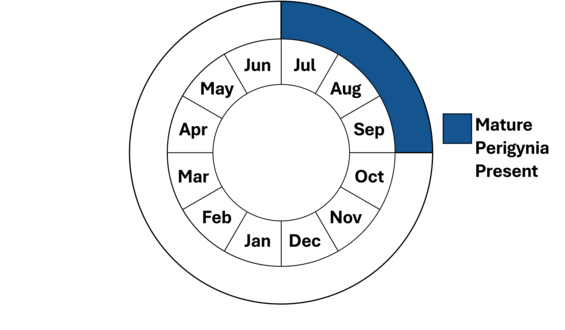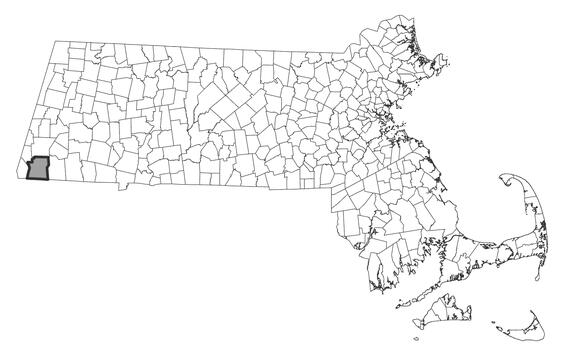- Scientific name: Carex davisii
- Species of Greatest Conservation Need (MA State Wildlife Action Plan)
- Endangered (MA Endangered Species Act)
Description
Davis’ sedge (Carex davisii) is a perennial sedge (family Cyperaceae) that grows in dense clumps up to 1 m (~3.3 ft) in height, in riparian habitats such as floodplain forests, alluvial meadows, and rich wooded banks. This species, a member, of the Carex section Hymenochlaene, is a relatively subtle and graceful sedge. The uppermost spikes are usually gynaecandrous (pistillate flowers borne above staminate flowers). The spikes have clusters of nodding perigynia (sing., perigynium) that become a distinctly orange-brown in color at maturity, contrasting with the pale, long-awned scales.
Sedges of the genus Carex have small unisexual wind-pollinated flowers borne in spikes. The staminate flowers are subtended by a single flat scale; the pistillate flowers are subtended by one flat scale (the pistillate scale) and are enclosed by a second sac-like modified scale, the perigynium. Following flowering, the achene (a dry, indehiscent, one-seeded fruit) develops within the perigynium. The morphological characters of these reproductive structures are important in identifying plants to species. A technical key is required to ensure correct identification. Davis’ sedge is a clump-forming plant with short creeping rhizomes and triangular culms (reproductive stems) that have a tendency to lie prostrate as the season progresses. The leaves are strap-like, flat, and slender (3 -8 mm; 0.12-0.31 in), and are often pubescent on the lower surface. Like other sedges in Carex section Hymenochlaene, the basal leaf sheaths are dark red-purple in color. The terminal spikes are usually gynaecandrous and the two or three lateral spikes are entirely pistillate. The spikes are typically borne on very slender and pubescent peduncles. The perigynia of Davis’ sedge (4.5-6 mm [0.18-0.24 in] long) are green to olive-green (turning orange-brown with age), often red dotted, ellipsoid to ovoid in shape; there are two prominent marginal veins plus several additional, evenly spaced veins that extend from the base to the apex. The scales that subtend the perigynia are translucent with a green midrib, each with a conspicuous pubescent awn. Mature perigynia are present throughout much of the summer.
Handsome sedge (Carex formosa; Threatened), a closely-related and rare sedge is similar to Davis’ sedge but has lateral gynaecandrous spikes, thicker and longer peduncles that usually exceed the length of the associated spike, shorter perigynia (3.5-5 mm [0.14-0.20 in] long) that do not turn orange-brown with age, and minute or absent awns on the pistillate scales.

Population status
Davis’ sedge is listed under the Massachusetts Endangered Species Act (MESA) as Endangered. All listed species under MESA are protected from killing, collecting, possessing, or sale and from activities that would destroy habitat and thus directly or indirectly cause mortality or disrupt critical behaviors. This species is known only from southern Berkshire County. The MassWildlife’s Natural Heritage & Endangered Species Program database has 4 records from Berkshire County. All 4 records have been observed within the last 25 years.
Distribution and abundance
Davis’ sedge is known from east-central Canada (Ontario), western New England south to Virginia, southwest to Texas, and throughout the Midwestern states to North Dakota and Nebraska.

Distribution in Massachusetts
1999-2024
Based on records in the Natural Heritage Database
Habitat
In Massachusetts, Davis’ sedge inhabits the moist alluvial soils of high terrace floodplain forests associated with rivers. Many populations are found within floodplain forests in low depressions or swales where they favor lower slopes and bottoms. Associated species include trees such as silver maple (Acer saccharinum) and green ash (Fraxinus pennsylvanica), and native shrubs such as hackberry (Celtis occidentalis) and wild black currant (Ribes americanum; watch list). There are common as well as rare sedges that co-occur with Davis’ sedge such as long-beaked sedge (Carex sprengelii), stiff sedge (C. amphibola) and the two state-threatened species foxtail-sedge (C. alopecoidea) and Gray’s sedge (C. grayi). Other herbaceous associates include wood-nettle (Laportea canadensis) and ostrich-fern (Matteuccia struthiopteris).
Healthy habitats are vital for supporting native wildlife and plants. Explore habitats and learn about conservation and restoration in Massachusetts.
Threats
Historic occurrences of Davis’ sedge elsewhere in New England are believed extirpated as a result of river impoundment and major development of its habitat. Thus, changes to the hydrologic regime due to local land use change could threaten the viability of a Davis’ sedge population.
Conservation
The exact management needs of Davis’ sedge are not known. As with all species, however, maintaining habitat quality is essential. Many populations are found in low depressions or swales within high terrace floodplain forests where plants receive periodic inundation; flooding is probably important for maintaining habitat quality and possibly for seed dispersal. Davis’ sedge habitat should be monitored for exotic invasive species. Invasive plants can out-compete native plants for nutrients and light, excluding them over time. Some invasive plants, such as garlic mustard (Alliaria petiolata) are allelopathic, meaning they can change the soil chemistry to inhibit the viability native plants. Exotic species of concern that occur in plant communities supporting Davis’ sedge are Japanese barberry (Berberis thunbergii), common buckthorn (Rhamnus cathartica), multiflora rose (Rosa multiflora), oriental bittersweet (Celastrus orbiculatus), garlic mustard, moneywort (Lysimachia nummularia), and reed canary grass (Phalaris arundinacea). If exotic plants are invading Davis’ sedge habitat, a plan for control should be constructed. All active management within the habitat of a rare plant population (including invasive species removal) is subject to review under MESA and should be planned in close consultation with the MassWildlife’s Natural Heritage & Endangered Species Program.
Contact
| Date published: | April 9, 2025 |
|---|